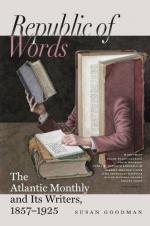It is one sign of our weakness, also, that we commonly assume Nature to be a rather fragile and merely ornamental thing, and suited for a model of the graces only. But her seductive softness is the last climax of magnificent strength. The same mathematical law winds the leaves around the stem and the planets round the sun. The same law of crystallization rules the slight-knit snow-flake and the hard foundations of the earth. The thistle-down floats secure upon the same summer zephyrs that are woven into the tornado. The dew-drop holds within its transparent cell the same electric fire which charges the thunder-cloud. In the softest tree or the airiest waterfall, the fundamental lines are as lithe and muscular as the crouching haunches of a leopard; and without a pencil vigorous enough to render these, no mere mass of foam or foliage, however exquisitely finished, can tell the story. Lightness of touch is the crowning test of power.
Yet Nature does not work by single spasms only. That chestnut spray is not an isolated and exhaustive effort of creative beauty: look upward and see its sisters rise with pile above pile of fresh and stately verdure, till tree meets sky in a dome of glorious blossom, the whole as perfect as the parts, the least part as perfect as the whole. Studying the details, it seems as if Nature were a series of costly fragments with no coherency,—as if she would never encourage us to do anything systematically, would tolerate no method but her own, and yet had none of her own,—were as abrupt in her transitions from oak to maple as the heroine who went into the garden to cut a cabbage-leaf to make an apple-pie; while yet there is no conceivable human logic so close and inexorable as her connections. How rigid, how flexible are, for instance, the laws of perspective! If one could learn to make his statements as firm and unswerving as the horizon-line,—his continuity of thought as marked, yet as unbroken, as yonder soft gradations by which the eye is lured upward from lake to wood, from wood to hill, from hill to heavens,—what more bracing tonic could literary culture demand? As it is, Art misses the parts, yet does not grasp the whole.
Literature also learns from Nature the use of materials: either to select only the choicest and rarest, or to transmute coarse to fine by skill in using. How perfect is the delicacy with which the woods and fields are kept, throughout the year! All these millions of living creatures born every season, and born to die; yet where are the dead bodies? We never see them. Buried beneath the earth by tiny nightly sextons, sunk beneath the waters, dissolved into the air, or distilled again and again as food for other organizations,—all have had their swift resurrection. Their existence blooms again in these violet-petals, glitters in the burnished beauty of these golden beetles, or enriches the veery’s song. It is only out of doors that even death and decay become beautiful. The model farm, the




